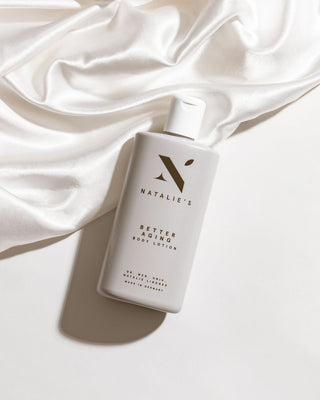Everyone knows them, has heard of them, and has probably used them. But what exactly are exfoliating skincare acids? And how and when should you use acids? We know that using exfoliating acids on the face seems daunting at first, but in fact, all skin types can benefit from incorporating acids into their skincare routine. There are different types of acids for any skin condition you want to treat, from acne, hyperpigmentation, dehydrated skin, wrinkles and fine lines to sensitive skin. Depending on the skin condition, different acids might be more effective, so be careful which acid you use if you want to achieve optimal results. But which acid is suitable for which skin problem?
Table of Contents
1. What types of acids are most commonly found in skincare products and how do they differ?
Exfoliating skincare acids are roughly divided into alpha-hydroxy acids, beta-hydroxy acids, and polyhydroxy acids which differ mainly in the degree of their penetration into the skin and the nature of their effect on the skin.
1.1. Alpha Hydroxy Acids (AHA)
These are the most commonly used acids and include Glycolic, Citric, Mandelic, Malic, Tartaric and Lactic acid. They exfoliate the skin, stimulate collagen and GAGs (glycosaminoglycans) formation. GAGs are important components of the extracellular matrix in the skin and play a crucial role in maintaining the structural integrity and elasticity of the skin. They are also responsible for moisture retention and thus contribute to skin hydration.
Additionally, Alpha hydroxy acids (AHAs) normalise the stratum corneum (the outer-most layer of the epidermis) and can regulate keratinization. AHAs are known for their water soluble properties, so they work on the skin’s surface. They are mostly used on normal to dry, sun-damaged skin, due to their ability to enhance natural moisturising factors within the skin. What is also really great about AHAs, is that they have evidence based effects on reducing sun damage, smoothing fine lines and wrinkles, exfoliating dead/dull looking skin cells and thereby making the skin appear smoother and more glowing! When the dead skin cells are removed, the active ingredients applied can absorb better, making the most out of your skincare routine.
Included in: Better Aging Body Lotion
1.2. Beta Hydroxy Acid (BHA)
There is only one beta hydroxy acid – salicylic – derived from acetylsalicylic acid, or aspirin. Like AHAs, beta hydroxy acid (BHA) also acts as an exfoliant increasing the shedding of dead skin cells. BHA is extremely useful for treating breakouts and helps manage keratosis pilaris (chicken skin) and other conditions that involve blocked or clogged pores. BHA works on both the skin’s surface and deep inside the pores. It’s oil soluble, so is best suited for normal to oily skin prone to bumps, clogs, blemishes and enlarged pores. BHA also has natural skin-calming properties, so it’s gentle enough for skin that's sensitive or prone to redness or rosacea. This well-rounded, gentle ingredient is even suitable for bumpy skin prone to milia, while improving the look of dull, dehydrated skin.
Included in: Purity Body Lotion
1.3. Polyhydroxy Acid (PHA)
Gluconolactone & Lactobionic Polyhydroxy acids (PHA) are next-generation Alpha Hydroxy acids, with the properties to exfoliate skin cells. They have larger molecules, and therefore cannot penetrate as deeply. PHAs are great for pigmentation, mild exfoliation and hydration. They support the matrix around collagen, help restore skin barrier function and protect against collagen degradation. PHAs are probably the most multi-tasking of all acids. Gluconolactone, lactobionic and maltobionic are examples of PHAs and best for signs of aging and sensitive or dehydrated skins.
Included in: Purity Body Lotion
2. What’s the main difference between AHAs and PHAs?
- AHAs are water soluble so they do not penetrate deeply beneath the skin’s surface. BHA is oil (lipid) soluble. This allows the BHA to penetrate oily pores and help to exfoliate the pore itself. This is why salicylic acid is particularly helpful when used on oily and acnaic skins. However, in order to work effectively, AHA and BHA exfoliants should have a pH value between 3 and 4.
- PHAs tend to be better for sensitive skins due to their larger molecular size and slower penetration. PHAs are great humectants on the skin, making them particularly good choices for dehydrated skins.
3. Which exfoliating skincare acids are best for which skin type?
3.1. Salicylic Acid
Derived from willow bark, salicylic acid is oil soluble and penetrates and breaks down the ‘glue’ that causes breakouts and oily, uneven skins. It loosens desmosomes (cell connections) allowing the cell to let go of the excess sebum that oily skins like to hold on to. Think of desmosomes as handcuffs, attaching your cells together. Salicylic acid dissolves these handcuffs to ensure better "cleaning".
Even those new to acids will probably have heard of salicylic acid. It’s the hero acid for those with acne-prone skin because it penetrates pores to reduce sebum. What’s more, it can remove discoloration and improve skin tone over time and can also be effective for treating rosacea. Dr. Verallo-Rowell, a renowned dermatologist, points out that it’s not for those who are pregnant, breastfeeding or allergic to aspirin. Those with darker complexions should also watch out because it can sometimes cause irregular lightening or darkening of skin.
3.2. Glycolic Acid
Containing the smallest molecule in AHAs, glycolic acid is derived from sugarcane and is the most effective AHA due to its ability to penetrate deeply and stimulate fibroblast cells to aid in collagen production. It exfoliates the skin by increasing cell turnover, evens skin tone and builds the support structure in the dermal matrix reducing wrinkles. It is the only acid that makes you sun sensitive, which is why attention should be paid to sun protection.
Overall, Glycolic acid is a versatile AHA that can help improve the appearance of spots, scars and wrinkles while making skin more radiant. Plus, it will shrink pores and is one of the best acids for aging skin.
Included in: Better Aging Body Lotion
3.3. Lactic Acid
Lactic acid is a key ingredient to remember for sensitive skin types. The acid exfoliates and softens fine lines and wrinkles, but in a less irritating way than other acids. Historically derived from milk, more recently synthetically formed to maintain stability, lactic acid works to dissolve the "glue" in between cells on the surface making it good for gently exfoliating. It keeps the skin soft and acts like Pac Man on the surface of the skin, gently eating the "glue" away.
Included in: Smooth Body Lotion
3.4. Mandelic Acid
Mandelic acid is an AHA derived from bitter almonds, but is gentler than some of the other AHAs like glycolic acid. Mandelic acid is ideal for brightening the skin and is a common ingredient in exfoliants. It is a good choice for oilier skin, as its molecules can penetrate even the oiliest skin. Mandelic acid is antibacterial and, when used regularly, can reduce the oiliness of the skin without drying it out much.
Included in: Glow Body Lotion
3.5. Azelaic Acid
People with redness often have concerns about using aggressive skin care products like acids. However, there is no need to fear azelaic acid. Azelaic acid is perfectly suitable for people with redness, rosacea and acne, and can also be used to treat hyperpigmentation and melasma.
Included in: Purity Body Lotion
3.6. Citric Acid
Citric acid reverses the signs of photodamage while improving the quality of the skin matrix. It is commonly used in skin care products to exfoliate, cleanse and brighten the skin. However, it is important to note that citric acid is a strong acidifier and can irritate and damage the skin if used incorrectly. Therefore, people with sensitive skin or skin conditions such as rosacea or acne should be cautious when using products with citric acid.
As a rule, citric acid is recommended for oily, acne-prone skin because it can remove excess oil and unclog pores. It can also help with dull, sun-damaged skin or hyperpigmentation, as it brightens the skin and promotes cell renewal.
Sometimes citric acid is used in skin care products just as a preservative so manufacturers can list it on the label. Make sure citric acid is specifically mentioned in the description on the packaging.
3.7. Tartaric and Malic Acid
Mainly derived from grapes/apples/pears and cherries, these two acids are among the gentler ones on the AHA scale. They are often used in skincare products for their antioxidant benefits and also aid in skin respiration.
Once you find an acid that suits your skin type, make sure you use it properly. For example, you should prefer to apply them at night and use them sparingly during the summer months, as acids often increase the skin's sensitivity to UV rays. For this reason, adequate sun protection is especially important.


